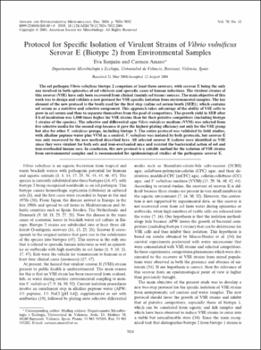Protocol for specific isolation of virulent strains of Vibrio vulnificus serovar E (Biotype 2) from environmental samples
Date
2004Abstract
The eel pathogen Vibrio vulnificus biotype 2 comprises at least three serovars, with serovar E being the only
one involved in both epizootics of eel vibriosis and sporadic cases of human infections. The virulent strains of
this serovar (VSE) have only been recovered from clinical (mainly eel tissue) sources. The main objective of this
work was to design and validate a new protocol for VSE-specific isolation from environmental samples. The key
element of the new protocol is the broth used for the first step (saline eel serum broth [SEB]), which contains
eel serum as a nutritive and selective component. This approach takes advantage of the ability of VSE cells to
grow in eel serum and thus to separate themselves from the pool of competitors. The growth yield in SEB after
8 h of incubation was 1,000 times higher for VSE strains than for their putative competitors (including biotype
1 strains of the species). The selective and differential agar Vibrio vulnificus medium (VVM) was selected from
five selective media for the second step because it gave the highest plating efficiency not only for the VSE group
but also for other V. vulnificus groups, including biotype 3. The entire protocol was validated by field studies,
with alkaline peptone water plus VVM as a control. V. vulnificus was isolated by both protocols, but serovar E
was only recovered by the new method described here. All selected serovar E isolates were identified as VSE
since they were virulent for both eels and iron-overloaded mice and resisted the bactericidal action of eel and
iron-overloaded human sera. In conclusion, this new protocol is a suitable method for the isolation of VSE strains
from environmental samples and is recommended for epidemiological studies of the pathogenic serovar E.





